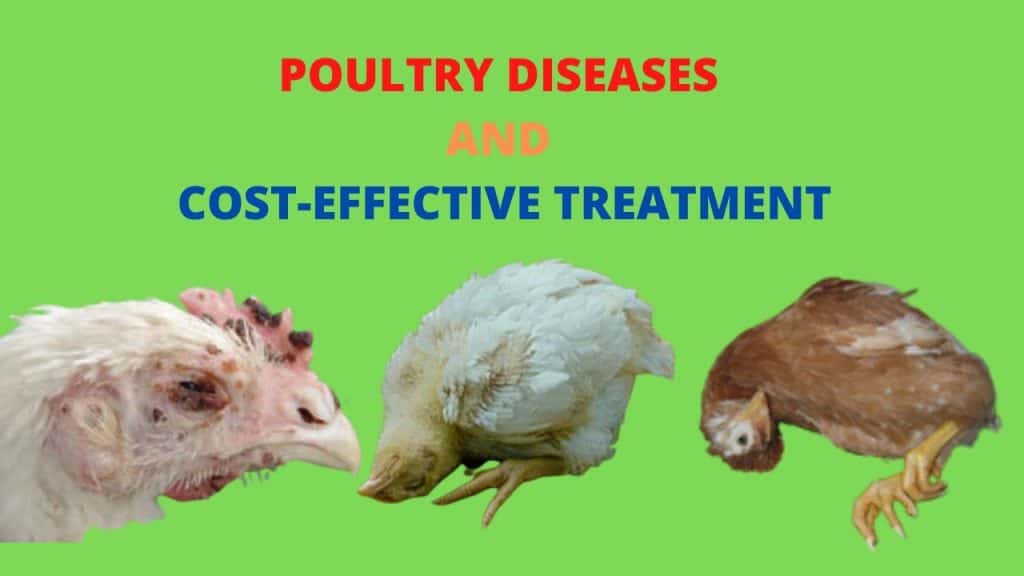Poultry is a popular business in animal husbandry, and it’s a lucrative one also.
However, to get a good yield, poultry diseases and prevention should be well planned.
Immunization of the birds is a very important management practice in poultry.
The birds should be immunized periodically to prevent most the common diseases and reduce the mortality rate in the pens.
Types of Poultry Diseases
Classification of poultry diseases is based on the causative agents, therefore, there are about 7 types of poultry diseases.
- Poultry bacterial diseases
- Poultry viral diseases
- Poultry neoplastic Diseases
- Poultry mycoses and Mycotoxicoses diseases
- Poultry parasitic diseases
- Poultry metabolic and nutritional diseases
- Poultry behavioral diseases
Common Poultry Diseases and Treatment
There are hundreds of diseases affecting poultry birds but the scope of this blog is to discuss the most common diseases, their symptoms, and treatment or preventive measures.
-
Gumboro Disease
Gumboro is a viral disease of chicken. Once a farm is infected by gumboro disease, it is very difficult to eradicate.
The virus is very infectious and can spread from bird to bird and from farm to farm within a relatively short period.
Farm to farm transmission is usually through infected equipment and clothing.
Layers are more susceptible to gumboro disease than broilers, and the most susceptible age is 3 to 6 weeks.
It has been diagnosed in chickens as young as one week and as 26 weeks.
Clinical signs of Gumboro
- Listless
- Depressed
- Pale
- Droopy
- Sleepy
- Whitish diarrhea
- Death
Prevention
The house and the equipment should be cleaned, washed, disinfected, and fumigated with 1% formalin or any other similar substance after a gumboro disease outbreak.
- Vaccination
- Good hygiene
- Avoid stress
Management
No specific treatment. You can give antibiotics to protect them from other infections.
-
Newcastle Disease
Newcastle disease is also a viral disease and it’s very contagious.
The disease is spread through infected droppings and respiratory discharge of birds, while farm to farm is through equipment, personnel, clothing, wild birds, and air.
Newcastle disease affects both young and adult birds with varying and severe consequences.
Clinical signs
- Depression
- The high mortality rate within 3 to 5 days
- Respiratory or nervous signs
- labored breathing
- Wheezing and gurgling
- Coughing or sneezing
- Paralysis or twisted neck
- A Drop in feed consumption
- A Drop in egg production
- Poor eggshell quality
- Greenish diarrhea
Prevention
- Vaccination
- Good hygiene
- Avoid stress
-
Fowl Pox Disease
The introduction of infected birds into a susceptible flock will cause an outbreak by direct contact.
Insects such as flies, and mosquitoes can also transmit fowlpox from bird to bird and from farm to farm.
Wounds by pecking or insect bites predispose birds to infection. However, there is low mortality and low recovery.
Fowlpox has a more devastating effect on chicks than on adults. There are two forms of the disease namely wet and dry pox.
Clinical Signs of Fowlpox
- In the at pox, there appear cheesy patches or growth on the mucous membranes of the mouth, tongue, or esophagus.
- In the dry form, there are nodules on the comb, wattle, and skin of the head.
- Depression
- lack of appetite
- Difficulty in breathing
- temporal drop in egg production
- Prevention
- Vaccination
- Good hygiene
Management
Remove dried nodules and apply skin ointment or iodine.
Even when an outbreak of fowl pox has been diagnosed, it is advisable to vaccinate the flock immediately to stop the further spread of the infection.










